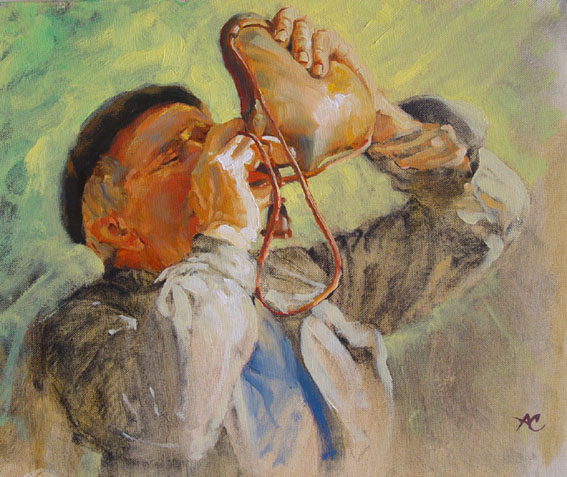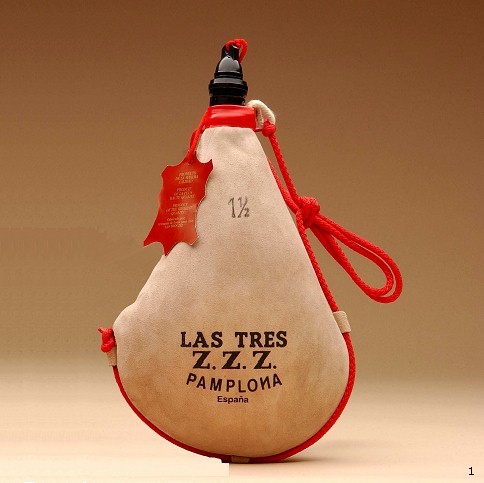 The ‘Bota’ or wineskin is a leather bag used to contain any kind of liquid, but it is typically used to preserve and transport wine. Spain is the country with the greatest 'Botera' tradition in the world. On any traditional festivity this instrument emerges as one of the stars being passed between friends. The ‘bota’ has been very important in Spanish history, being one of the containers used most by the Spanish people.
The ‘Bota’ or wineskin is a leather bag used to contain any kind of liquid, but it is typically used to preserve and transport wine. Spain is the country with the greatest 'Botera' tradition in the world. On any traditional festivity this instrument emerges as one of the stars being passed between friends. The ‘bota’ has been very important in Spanish history, being one of the containers used most by the Spanish people.
The original history of the ‘bota’ was really lost in ancient times but it was the Spanish that kept it alive. Written evidence of its existence has been found as far back as ancient Greece (Homer in the Odyssey when Ulysses the hero gets Cyclops Polyphemus drunk by giving him wine in skins), in the Bible (Noah’s children got him drunk too using similar artefacts), in the immortal Cervantes' Don Quixote (when the old gentleman takes swipes and lunges at the landlord) and throughout the Golden Age of Spanish literature the references multiply.
Lightweight, flexible, durable, environmentally friendly, easy to carry, waterproof, practical, hygienic, attractive, simple but perfect in design, the wineskin is a legacy of our past and a product that charms those who know how to enjoy the basic pleasures of life.
Traditional models are shaped as a water drop and usually have a curved face to facilitate the movement of liquid from the container to the user's mouth.
There are two types of wineskin that vary because of their interior. Firstly there is the interior known as ‘pez’ (derived from pine or juniper resin and it is used for waterproofing the inside of the wineskin) and then there is the interior with latex. Latex wineskins instead of having resin waterproofing have a wineskin shaped latex bag inside the skin, which actually contains the liquid.

The “pez” interior wineskin is the original ‘Bota’, the one that has been used for generations. If you want to use it mainly for wine you are recommended to choose the traditional format. If you want to use it for water or carbonated sweet drinks, your choice should be latex.
The companies ‘Boteria Jesus Blasco’, ‘Las Tres ZZZ’ and ‘Boteria Domingo los tres D.D.D’ are the main producers of traditional Spanish wineskins. All with a history dating back to the late 19th century.
The wineskin is an iconic Spanish product and any occasion is a good excuse to enjoy it, whether walking or just getting together with some friends. It is a tradition that will not be lost despite the new drink containers that large companies are constantly putting on sale.
This handmade tradition will continue because of its uniqueness and heritage. The skin used for the traditional ‘bota’ is goat’s skin from local Spanish herds and it is a leather specialist who carefully selects each goat.
Once dried, the skin is treated with vegetable tannins or extracts obtained from grounded tree bark (mimosa, pine and oak). Once ready and with the help of a guide, the skin is cut.
Once cut, the skin is folded in the middle, matching the edges and creating the shape of the water drop. During the production process the wineskin is worked inversely to its natural form and then coated with a waterproofing layer of resin.
Sewing the wineskin properly is the secret to its durability. The outer stitching, now done with a sewing machine over the past decades, is sewn in a criss-cross manner allowing it to be totally sealed and hermetic. This also makes the stitching incredible strong.
Once sewn, it needs to be turned ‘outside in’ so the stitching is on the inside. This process requires a highly experienced craftsman with a special rod. First he blows hard to inflate it and with a flick of the wrist turns it on the rod.
At this point, the wineskin is ready for the waterproofing resin inside. The ’pez’, which after being cooked, is now in a liquid state and it is poured into the ‘bota’ to permeate throughout the interior. Once the ‘pez’ has cooled, the ‘bota’ is waterproofed.
In latex wineskins, this process is completely replaced by introducing a latex bladder which performs the same function of waterproofing and containing the liquid. Finally, the spout or nozzle is placed on the top and attached to the skin.
Once checked over, the last step is to add a cord for carrying the wineskin, which is sown in place. Once added, it would now be ready for use.
Wineskins are said to be very much like good wine; they get better with age if maintained correctly, those that use them frequently claim it even contributes positively to the flavour of the wine over time. However, this will be very much a question of personal preference, so I encourage you to give it a go.